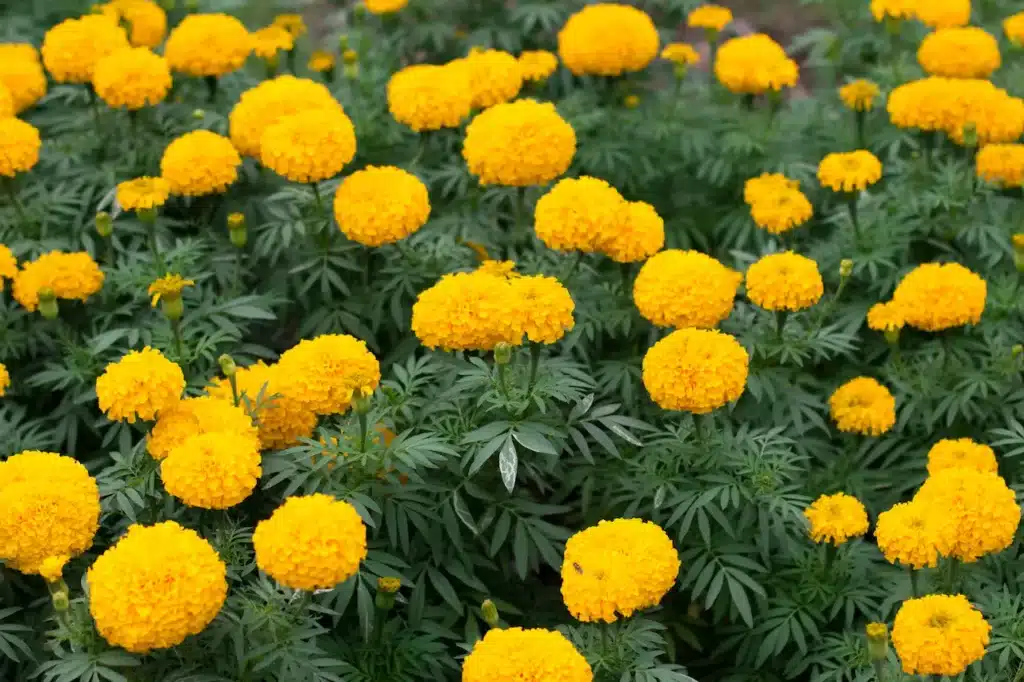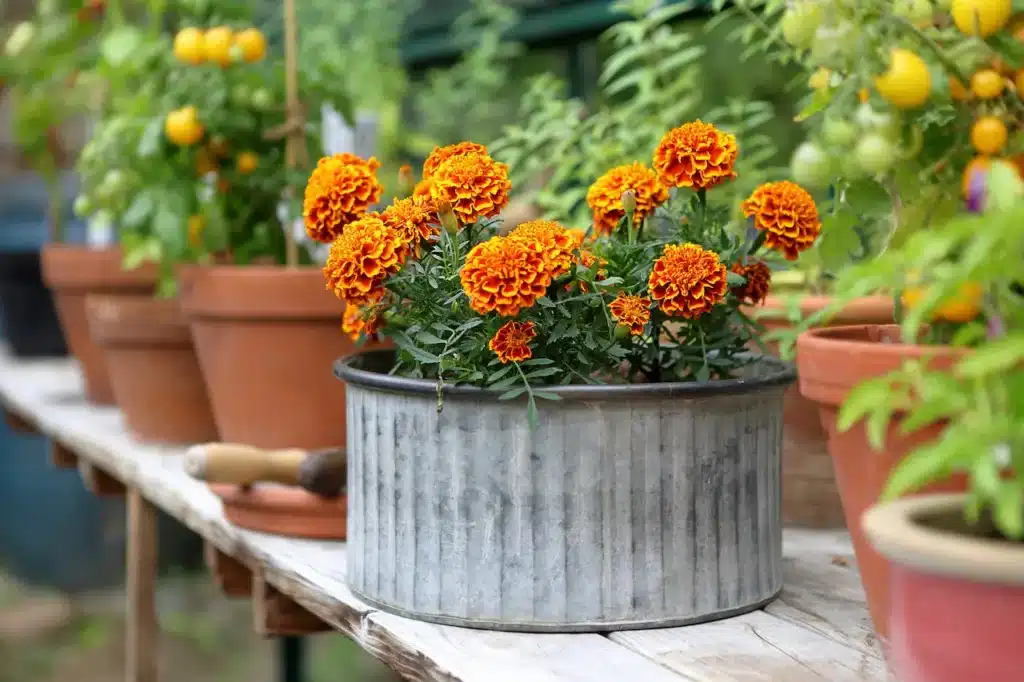How to Grow & Care for Marigolds
How to Grow & Care for Marigolds (Genda Phool) for Festive Blooms: A Complete Guide
Introduction
Marigolds, or Genda Phool as they are fondly known in India, are among the most cherished and versatile flowers in Indian gardens, especially during the festive season. Their bright, cheerful colors ranging from vibrant yellow and orange to subtle whites, reds, and even bi-colored varieties make them a staple for festival decorations. Whether it’s Diwali, Navratri, or any other celebration, marigolds are the go-to flowers for adding a burst of color to homes, temples, and public spaces. They bring an element of joy and vibrancy that aligns perfectly with the spirit of these celebrations.
But marigolds are not just valued for their stunning appearance. They are also well-known for their pest-repellent properties and their ability to thrive with minimal care. Whether you’re a seasoned gardener or just starting out, marigolds (Genda Phool) make a perfect addition to any garden. Their hardy nature, combined with their ornamental and functional qualities, makes them a must-have in any festive garden.
In this complete guide, we’ll dive into everything you need to know about growing and caring for marigolds at home, from choosing the right variety to maintaining them for long-lasting festive blooms. Best of all, Lazy Gardener’s products such as BloomStix and Bloom Spray can help ensure that your marigolds bloom brightly, season after season.

Types of Marigolds Common in India
Marigolds are available in a variety of species, each with distinct features. In India, three main types of marigolds are commonly grown:
1. French Marigold (Tagetes patula)
French marigolds are one of the most popular and easy-to-grow varieties in Indian gardens. Known for their compact growth and bushy habit, they are often seen in vibrant shades of yellow, orange, and red. These marigolds are perfect for small garden spaces, container gardening, and as border plants. They thrive in almost all soil types, as long as the soil is well-drained. French marigolds are also prized for their pest-repellent properties, making them an excellent companion plant for vegetables and other flowers.
- Key Features
– Compact, bushy growth
– Bright colors (yellow, orange, red)
– Excellent for small spaces, borders, and containers
2. African Marigold (Tagetes erecta)
Larger and taller than French marigolds, African marigolds produce bold, ball-shaped flowers in shades of bright yellow and orange. These “big bloomers” are ideal for flower beds and large garden spaces, where their towering stems and large blooms can make a dramatic impact. African marigolds are often used in festive garlands and religious ceremonies and are a classic symbol of prosperity and good luck in Indian culture.
- Key Features
– Large, ball-shaped flowers
– Ideal for flower beds and large garden areas
– Strong visual impact, perfect for festive decorations
3. Mexican Marigold (Tagetes lucida)
Mexican marigolds are a more unique variety, known for their aromatic, citrus-scented leaves and vibrant golden-yellow flowers. These marigolds are particularly valued for their adaptability, drought tolerance, and their use in traditional rituals and offerings. In India, they are often used for religious purposes and in garlands for special occasions. Their medicinal properties and ability to thrive in dry, hot conditions make them an excellent choice for gardeners in arid climates.
- Key Features:
-Aromatic citrus-scented leaves
-Golden-yellow flowers
-Drought-tolerant and ideal for hot, dry climates
Each of these varieties brings a different charm to your garden, making marigolds a versatile and valuable flower for adding color, fragrance, and cultural significance to your home during festive seasons.

Step-by-Step Guide to Growing Marigolds
Marigolds are relatively easy to grow, even for beginners. By following this step-by-step guide, you can ensure that your marigolds grow healthy and produce beautiful, vibrant blooms.
1. Choosing the Right Location
Marigolds are sun-loving plants and thrive best when exposed to at least 6-8 hours of direct sunlight each day. Whether you’re planting them in your garden or in containers, choose a location that receives plenty of sunlight. Marigolds grown in shaded areas will still bloom, but their growth may be weaker, and the flowers may not be as profuse.
Pro Tip: In areas with partial shade, marigolds can still grow, but they might not bloom as abundantly.
2. Preparing the Soil
Marigolds are not particularly fussy about soil, but they do best in well-draining soil with a slightly sandy texture. The soil should be rich in organic matter to support healthy root growth. Before planting, make sure to amend your soil with compost or organic matter to improve fertility and drainage. If planting in containers, use a good quality potting mix.
Pro Tip: Use Lazy Gardener’s BloomStix to enrich the soil with essential nutrients, which promotes stronger roots and better flowering.
3. Sowing the Seeds or Transplanting Seedlings
You can grow marigolds from seeds or seedlings, depending on your preference and the season.
Sowing Seeds: If you are starting from seeds, plant them directly in the garden soil, spacing them about 8–12 inches apart, depending on the variety. For indoor sowing, use seed trays or small pots filled with a light potting mix. Marigold seeds typically germinate within 5–7 days when kept in a warm environment.
Transplanting Seedlings: If you prefer to transplant seedlings, purchase healthy young plants from a nursery. Make sure the seedlings have strong stems and vibrant leaves. When transplanting, ensure the plants are spaced adequately to allow for healthy growth and air circulation.
Pro Tip: To give your seedlings a boost, spray them with **Bloom Spray** every 7-10 days. It’s packed with essential nutrients that encourage lush, vibrant blooms.
4. Watering
Marigolds are relatively drought-tolerant once established, but they need consistent watering, especially during their early growth stage. Water the plants when the top inch of the soil feels dry, but make sure the soil is not waterlogged, as marigolds are susceptible to root rot. When planting in containers, ensure the pots have drainage holes to prevent water from accumulating.
Pro Tip: During the monsoon season or rainy periods, use plant stands for container plants to ensure proper drainage and avoid waterlogging.
5. Fertilizing
While marigolds are light feeders, they do benefit from regular fertilization. To ensure strong growth and vibrant blooms, use a balanced, slow-release fertilizer every 3–4 weeks. Lazy Gardener’s BloomStix is an excellent choice, as it gradually releases nutrients into the soil, promoting healthy plant growth without overfeeding.
If you notice that your plants are producing more leaves than flowers, consider switching to a fertilizer with a higher phosphorus content, which encourages blooming.
6. Deadheading for More Blooms
Deadheading, or removing spent flowers, is an essential part of marigold care. By cutting off the faded flowers, you encourage the plant to focus on producing new blooms rather than going to seed. Regular deadheading also helps to maintain the plant’s aesthetic appearance.
Pro Tip: Use Lazy Gardener’s Anvil Cutters for precise and easy pruning. This will help you deadhead your marigolds without causing unnecessary damage to the plant.
Caring for Marigolds During the Festive Season
As marigolds mature, they become quite resilient and require minimal care. However, to keep your marigolds looking their best throughout the festive season, here are a few tips:
Pest Control
Marigolds are natural insect repellents, but they may occasionally attract pests like aphids and whiteflies. To keep these pests at bay, use organic neem oil spray or insecticidal soap. Spray the plants once every 10–14 days for effective pest control.
Pruning
To maintain a tidy appearance and promote better airflow, regularly prune any excessive foliage. This will reduce the risk of fungal infections, especially during humid conditions.
Water Management
Be careful not to overwater marigolds, particularly during the monsoon season. Ensure the soil drains well and that water does not accumulate around the plant’s base. For plants in containers, using plant stands can prevent waterlogging.
Marigold Colors for Your Festive Garden
Marigolds come in a variety of colors, each carrying its own meaning and appeal. Here are some popular marigold colors that will brighten your garden during the festive season:
1. Yellow Marigold: Known for symbolizing positivity and happiness, yellow marigolds are perfect for adding warmth to your garden and home.
2. Orange Marigold: Vibrant orange marigolds are especially popular during Diwali, as they symbolize energy and celebration.
3. White Marigold: Elegant and unique, white marigolds bring serenity and grace to your garden, offering a peaceful contrast to the more vibrant hues.
4. Red Marigold: Bold and dramatic, red marigolds create striking contrasts and are ideal for festive decor, especially during auspicious ceremonies.
5. Gold Marigold: Golden marigolds symbolize prosperity and abundance, making them a must-have for any festive garden.
6. Bi-Color Marigold: With multiple colors in one bloom, bi-color marigolds add adynamic, dramatic flair to your garden displays.

Conclusion
Growing marigolds is an incredibly rewarding experience, especially during the festive season when their vibrant blooms can enhance celebrations. With minimal care, regular fertilization using **BloomStix**, and the occasional boost from Bloom Spray, you can enjoy a flourishing garden full of marigolds that brighten your home and your festivities.
Get started on your marigold-growing journey today, and transform your garden into a festive paradise with the help of Lazy Gardener’s premium gardening products. Whether you’re growing them in your garden, in containers, or as part of your Diwali or Navratri decorations, marigolds are sure to bring joy and beauty to your home all year round.




